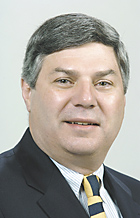
“‘To withdraw, to go away, to disappear.’ That’s how the dictionary defines retirement. Time to redefine. Your generation is definitely not headed for bingo night. In fact you could write a book about how you’re going to turn retirement upside down.”
—Dennis Hopper in Ameriprise commercial
With the baby boomers relentlessly advancing into retirement, it is important for us to understand how they are going to rock our world. They’ve changed everything they’ve touched and they’ll change what we do as well—count on it!
It’s like a python eating a pig … and that bulge is coming our way.
With this in mind, ZMG and Corporate Research worked together and talked with dozens of senior housing executives from the mid-Atlantic area and conducted an extensive review of literature to find out how retirement communities are planning to deal with this onslaught of baby boomers. This research was presented at the AOPHA Conference in Columbus, Ohio.
It’s well-established that the boomers are BIG. There are 76 million boomers racing towards retirement. The oldest boomers (born in 1946) are 62, a short 15 years away from the prime age that they begin moving into independent living communities. The Brookings Institute concluded that, “The aging of the baby boom generation makes pre-seniors this decade’s fastest-growing age group, expanding nearly 50 percent in size from 2000 to 2010.”
In addition, William Frey said, “The magnitude and characteristics of senior growth will vary widely from place to place. In many cases, areas known for their youthful populations—especially the Sun Belt and suburbs—will undergo the most rapid senior growth.”
According to AARP there are currently 16,000 nursing homes in the United States, 39,500 assisted living facilities (ALFs), 1,900 continuing care retirement communities (CCRCs) and 300,000 units of Section 202 Affordable Housing. The waiting list for Section 202s averages 13.4 months. Currently, there are 1.4 million nursing home residents, 900,000 residents in ALFs, 750,000 independent living (IL) residents, some 150,000 use adult day services and 1.4 million utilize home health.
But that’s today—only about half of the senior population that is anticipated when the boomers hit our industry!
The growth will be widespread and universal. Brookings commented that even “the state with the slowest projected growth in 55-to-64-year-olds is New York, where their numbers will still increase by 33 percent from 2000 to 2010.”
When the boomers hit our demographic, there will be about 3.8 million of them seeking independent living and CCRC accommodations (assuming that 5% continue to opt for this type of retirement living). Compare this to “only” 750,000 IL residents today, and you’ll begin to get a feel for the magnitude of this generation.
This tidal wave of retirees also opens virtually endless possibilities for expanding service offerings into the home health arena for those millions who won’t move into IL or eschew even AL options, rather preferring to “age in place” at home with family.
According to our survey, the average age of skilled nursing facilities (SNFs), ALFs and ILs are all about nine to 10 years, with renovations having occurred about three to four years ago. Expansion of each of these service areas is expected to occur in the next three and half to four and half years.
That’s great, but are we really ready for this coming flood into our systems?
Fifteen years will be upon us before we know it. Just think back to how quickly the past 15 years has passed. For instance, in 1993: Michael Jordan was winning NBA Championships in Chicago; The Buffalo Bills were losing Super Bowls; “Jurassic Park” was the hottest flick; and “Home Improvement” and “Seinfeld” were the top television shows. It doesn’t seem that long ago, does it? The next 15 years will be upon us quicker than ever.
Next, we wanted to find out who these baby boomers are and what kinds of products and services they will demand.
Here are some things to ponder (compare these traits to those of your current residents):
* 80% use computers daily
* They will demand excitement in retirement.
* They can’t sit still. Jogging, biking, tai chi and tae bo, power walking and yoga — all of this is just part and parcel of a boomer’s daily routine. Call it the Peter Pan Syndrome: They just won’t grow up!
* This generation may be the first to die of something other than old age.
* Healthier and wealthier than any previous generation, they grew up in an era seeded with hope, revolution and verdant creativity.
* Communities will need to deliver high value and prestige without pricing the product out of reach.
* Baby boomers are looking for something different; cookie-cutter developments are out.
* Good transportation infrastructure is a plus—boomers don’t want to have to drive everywhere. Walking, biking and golf carts are OK, just as long as they don’t have to drive everywhere.
* Either out of financial necessity or simply because they want to keep active, 80% of them don’t ever plan to retire, so they may be working while living at a retirement community.
Ready or not, here they come! In 15 years, the “Kids of the Baby Boom” will be knocking on our doors.
Will you be ready for them? It’s not too soon to contemplate. The future success of your community depends on it!
W.R. “Chip” Zimmer, Ph.D., is president of the Zimmer Marketing Group, Hagerstown, MD. For more detailed information, go to www.zimmermarketinggroup.com and click on “The Boomers Are Coming” button.




